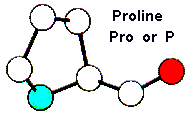

For an updated version of these pages, click here


Substitution preferences:
All protein types:
| Favoured | ||||||||
| Disfavoured | Ala (-1) | Lys (-1) | Asp (-1) | Glu (-1) | Gln (-1) | Ser (-1) | Thr (-1) | His (-2) |
| Arg (-2) | Asn (-2) | Gly (-2) | Val (-2) | Met (-2) | Leu (-3) | Cys (-3) | Tyr (-3) | |
| Ile (-3) | Phe (-4) | Trp (-4) |
| Favoured | ||||||||
| Neutral | Ala ( 0) | Asp ( 0) | Glu ( 0) | Lys ( 0) | Gly ( 0) | Gln ( 0) | Arg ( 0) | Ser ( 0) |
| Thr ( 0) | ||||||||
| Disfavoured | His (-1) | Met (-1) | Val (-1) | Tyr (-1) | Asn (-1) | Phe (-2) | Ile (-2) | Trp (-2) |
| Leu (-2) | Cys (-2) |
| Favoured | ||||||||
| Neutral | Ala ( 0) | Gln ( 0) | Asp ( 0) | Glu ( 0) | Asn ( 0) | Gly ( 0) | His ( 0) | Leu ( 0) |
| Lys ( 0) | Arg ( 0) | Ser ( 0) | Thr ( 0) | Val ( 0) | ||||
| Disfavoured | Ile (-1) | Met (-1) | Tyr (-1) | Phe (-2) | Trp (-3) | Cys (-6) |
| Favoured | ||||||||
| Neutral | Ala ( 0) | Gln ( 0) | ||||||
| Disfavoured | Leu (-1) | Ser (-1) | Gly (-1) | Thr (-1) | Asn (-2) | Asp (-2) | Glu (-3) | Val (-3) |
| Ile (-3) | Arg (-3) | Met (-3) | His (-4) | Phe (-4) | Lys (-4) | Cys (-4) | Tyr (-5) | |
| Trp (-6) |
Role in structure:
Proline is unique in that it is the only amino acid where the side chain is connected to the protein backbone twice, forming a five-membered nitrogen-containing ring. Strictly speaking, this makes Proline an imino acid (since in its isolated form, it contains an NH2+ rather than an NH3+ group, but this is mostly just pedantic detail). This difference is very important as it means that Proline is unable to occupy many of the main chain conformations easily adopted by all other amino acids. In this sense, it can be considered to be an opposite of Glycine, which can adopt many more main-chain conformations. For this reason, Proline can often be found in very tight turns in protein structures (i.e. where the polypeptide chain must change direction). It can also function to introduce kinks into alpha helices, since it is unable to adopt a normal helical conformation.
Despite being aliphatic and hydrophobic, the preference for turn structure means that Prolines are usually be found on the protein surface.Role in function:
Proline plays important roles in molecular recognition, particularly in intracellular signalling. Domains such as WW and SH3 bind to specific proline containing peptides that are key parts of many signalling cascades. Here proline binds to a surface containing aromatic residues via a process that is to date not well understood.
Otherwise, the Proline side chain is very non-reactive. This, together with its difficulty in adopting many protein main-chain conformations means that it is very rarely involved in protein active or binding sites.